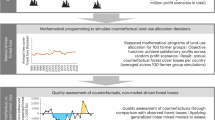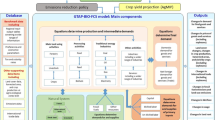Abstract
A model of product and land markets in U.S. forest and agricultural sectors is used to examine the private forest management, land use, and market implications of carbon sequestration policies implemented in a" least social cost" fashion. Results suggest: policy-induced land use changes may generate compensating land use shifts through markets; land use shifts to meet policy targets need not be permanent; implementation of land use and management changes in a smooth or regular fashion over time may not be optimal; and primary forms of adjustment to meet carbon policy targets involve shifting of land from agriculture to forest and more intensive forest management in combinations varying with the policy target.
Similar content being viewed by others
References
Adams, D. M. and R. W. Haynes (1996), The 1993 Timber Assessment Market Model: Structure, Projections, and Policy Simulations. USDA Forest Service, Pacific Northwest Res. Stn., Gen. Tech. Rep., GTR-PNW-358, Portland, OR.
Adams, D., R. Alig, B.A. McCarl, J.M. Callaway, and S. Winnett (1996a), ‘An Analysis of the Impacts of Public Timber Harvest Policies on Private Forest Management in the U.S.', Forest Science 42(3), 343–358.
Adams, D., R. Alig, J.M. Callaway, B. McCarl, and S. Winnett (1996b), The Forest and Agricultural Sector Optimization Model (FASOM): Model Structure and Policy Applications. USDAForest Service Pacific Northwest Research Station Research Paper PNW-RP-495. Portland, Oregon. 60 pp.
Adams, R., D. Adams, J. Callaway, C. Chang, and B. McCarl (1993), ‘Sequestering Carbon on Agricultural Land: Social Costs and Impacts on Timber Markets', Contemporary Policy Issues XI, 76–87.
Alig, R. (1986), ‘Econometric Analysis of the Factors Influencing Forest Acreage Trends in the Southeast', Forest Science 32(1), 119–134.
Alig, R., J. Vasievich, and K. Lee (1992), ‘Economic Opportunities to Increase Timber Growth on Timberland', in A. Qureshi, ed., Forests in a Changing Climate, Climate Institute, Washington, D.C. pp. 115–125.
Alig, R. and D. Wear (1992), ‘U.S. Private Timberlands, 1952–2040', Journal of Forestry 90(5), 31–36.
Alig, R., D. Adams, and B. McCarl (1996), ‘Land Exchange between Agriculture and Forestry: Impacts of Federal Farm Support and Conservation Policies’ (Draft). Corvallis, Oregon.
Birdsey, R. (1992), ‘Carbon Storage in Trees and Forests', in N. Sampson and D. Hair, eds., Forests and Global Change: Volume I – Opportunities for Increasing Forest Cover, American Forestry Association. pp. 23-40.
Burton, D., B. McCarl, D. Adams, R. Alig, J. Callaway, and S. Winnett (1995), ‘An Exploratory Study of the Economic Impacts of Climate Change on Southern Forests', in USDA Forest Service General Technical Report SE-92, Asheville, North Carolina. pp. 5–18, 45 pp.
Callaway, J. and B. McCarl (1995), ‘The Economic Consequences of Substituting Carbon Payments for Crop Subsidies in U.S. Agriculture', Environmental and Resource Economics 5, 1–29.
Chang, C., B. McCarl, J. Mjelde, and J. Richardson (1992), ‘Sectoral Implications of Farm Program Modifications', American Journal of Agricultural Economics 74, 38–49.
Haynes, R., R. Alig, and E. Moore (1994), Alternative Simulations of Forestry Scenarios Involving Carbon Sequestration Options. USDA Forest Service Gen. Tech. Rep. PNW-GTR-335. Pacific Northwest Res. Stn. Portland, Oregon. 66 p.
Haynes, R., D. Adams, and J. Mills (1995), The 1993 RPA Timber Assessment Update.USDA Forest Service Gen. Tech. Rep. RM-259. Ft. Collins, CO., Rocky Mountain Forest and Range Experiment Station. 66 p.
McCarl, B., C. Chang, J. Atwood, and W. Nayda (1993), The U.S.Agricultural Sector Model. Texas A&M University, College Station, TX. (Draft).
Moulton, Robert J. and Kenneth R. Richards (1990), Costs of Sequestering Carbon Through Tree Planting and Forest Management in the United States. USDA Forest Service Gen. Tech. Rep. WO-58. Washington, D.C. 44 p.
Parks, P. J. and I. W. Hardie (1995), ‘Least-Cast Forest Carbon Reserves: Cost Effective Subsidies to Convert Marginal Agricultural Land to Forests', Land Economics 71(1), 122–136.
Takayama, T. and G. G. Judge (1971), Spatial and Temporal Price and Allocation Models. North-Holland Press, Amsterdam.
Turner, D. et al. (1993), The Forestland Carbon Budget of the U.S.: Current Status and Evaluation. Final Rep., Environ. Protection Agency. ManTech, Corvallis, Oregon.
USDA Forest Service (1990), An Analysis of the Timber Situation in the United States: 1989–2040. USDA Forest Service RM GTR 199. Rocky Mountain Forest and Range Experiment Station, Ft. Collins. 268 pp.
USDA Soil Conservation Service (1989), The Second RCA Appraisal: Soil, Water, and Related Resources on Nonfederal Land in the United States; Analysis of Conditions and Trends.Wash-ington, D.C. 280 pp.
USDA Soil Conservation Service (1994), The 1992 National Resources Inventory: Preliminary Results. (Draft). Washington, D.C.
Author information
Authors and Affiliations
Rights and permissions
About this article
Cite this article
ALIG, R., ADAMS, D., MCCARL, B. et al. Assessing Effects of Mitigation Strategies for Global Climate Change with an Intertemporal Model of the U.S. Forest and Agriculture Sectors. Environmental and Resource Economics 9, 259–274 (1997). https://doi.org/10.1023/A:1026409105660
Issue Date:
DOI: https://doi.org/10.1023/A:1026409105660




